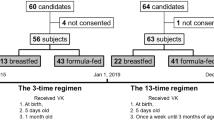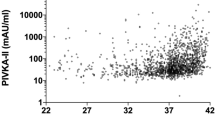Abstract
Little is known about the metabolic turnover and excretion of vitamin K in healthy newborn infants and the metabolic consequences of prophylactic regimens designed to protect against vitamin K deficiency bleeding (VKDB). We measured the excretion of two urinary metabolites (≤24 h) of vitamin K (5C- and 7C-aglycones) in term infants before (n = 11) and after (n = 5) a 1000 μg i.m. dose of vitamin K1 (K1) and in preterm infants after 200 μg i.m. (n = 4), 500 μg i.m. (n = 4), or 200 μg i.v. (n = 5). In preterm infants, we also measured serum K1, vitamin K1 2,3-epoxide, and PIVKA-II at 5 d postpartum. Before prophylaxis, the rate of 5C- and 7C-aglycone excretion was 25 times lower than adults, reflecting low vitamin K stores at birth. After prophylaxis, the excretion rate correlated to K1 dose (r = 0.6) but was two orders of magnitude lower than that in adults, probably reflecting the immaturity of neonatal catabolism. All term and 10 of 13 preterm infants mainly excreted 5C-aglycone. We present evidence that increased excretion of the 7C-aglycone was associated with metabolic overload because of the exposure to high-tissue K1 concentrations. Measurement of the 5C- and 7C-aglycones may facilitate longitudinal studies of vitamin K status in neonates and aid the development of improved prophylactic regimens.
Similar content being viewed by others
Log in or create a free account to read this content
Gain free access to this article, as well as selected content from this journal and more on nature.com
or
Abbreviations
- 5C-aglycone:
-
2-methyl-3-(3′-3′-carboxymethylpropyl)-1,4-naphthoquinone
- 7C-aglycone:
-
2-methyl-3-(5′-carboxy-3′-methyl-2′-pentenyl)-1,4-naphthoquinone metabolite
- Gla:
-
γ-carboxyglutamate residues
- K1:
-
vitamin K1 or phytomenadione
- K1O:
-
vitamin K1 2,3-epoxide
- K2:
-
menaquinones
- PIVKA-II:
-
undercarboxylated factor II
- VKOR:
-
vitamin K1 2,3-epoxide reductase
- VKDB:
-
vitamin K deficiency bleeding
References
Suttie JW 2009 Vitamin K in Health and Disease. Taylor & Francis Group, Boca Raton, FL
Shearer MJ, Barkhan P, Rahim S, Stimmler L 1982 Plasma vitamin K1 in mothers and their newborn babies. Lancet 2: 460–463
Haroon Y, Shearer MJ, Rahmin S, Gunn WG, McEnery G, Barkhan P 1982 The content of phylloquinone (vitamin K1) in human milk, cows milk and infant formula foods determined by high-performance liquid chromatography. J Nutr 112: 1105–1117
Institute of Medicine 2001 Dietary Reference Intakes for Vitamin A, Vitamin K, Arsenic, Boron, Chromium, Copper, Iodine, Iron, Manganese, Molybdenum, Nickel, Silicon, Vanadium, and Zinc. National Academy Press, Washington, DC
Itoh S, Onishi S 2000 Developmental changes of vitamin K epoxidase and reductase activities involved in the vitamin K cycle in human liver. Early Hum Dev 57: 15–23
Bovill EG, Soll RF, Lynch M, Bhushan F, Landesman M, Freije M, Church W, McAuliffe T, Davidson K, Sadowski J 1993 Vitamin K1 metabolism and the production of des-carboxy prothrombin and protein C in the term and premature neonate. Blood 81: 77–83
Greengard O 1977 Enzyme differentiation of human liver: comparison with the rat model. Pediatr Res 11: 669–676
Shearer MJ 2009 Vitamin K deficiency bleeding (VKDB) in early infancy. Blood Rev 23: 49–59
Ansell P, Roman E, Fear NT, Renfrew MJ 2001 Vitamin K policies and midwifery practice: questionnaire survey. BMJ 322: 1148–1152
Clarke P, Mitchell S 2003 Vitamin K prophylaxis in preterm infants: current practices. J Thromb Haemost 1: 384–386
Kumar D, Greer FR, Super DM, Suttie JW, Moore JJ 2001 Vitamin K status of premature infants: implications for current recommendations. Pediatrics 108: 1117–1122
Costakos DT, Greer FR, Love LA, Dahlen LR, Suttie JW 2003 Vitamin K prophylaxis for premature infants: 1 mg verus 0.5 mg. Am J Perinatol 20: 485–490
Clarke P, Vitamin K prophylaxis for preterm infants. Early Hum Dev 86: 17–20
Golding J, Greenwood R, Birmingham K, Mott M 1992 Childhood cancer, intrammuscular vitamin K, and pethidine given during labour. BMJ 305: 341–346
Fear NT, Roman E, Ansell P, Simpson J, Day N, Eden OB, United Kingdom Childhood Cancer Study Investigators 2003 Vitamin K and childhood cancer: a report from the United Kingdom Childhood Cancer Study. Br J Cancer 89: 1228–1231
Andrew M 1997 The relevance of developmental hemostasis to hemorrhagic disorders of newborns. Semin Perinatol 21: 70–85
Shearer MJ, Barkhan P 1973 Studies on the metabolites of phylloquinone (vitamin K1) in the urine of man. Biochim Biophys Acta 297: 300–312
Harrington DJ, Soper R, Edwards C, Savidge GF, Hodges SJ, Shearer MJ 2005 Determination of the urinary aglycone metabolites of vitamin K by HPLC with redox-mode electrochemical detection. J Lipid Res 46: 1053–1060
Harrington DJ, Booth SL, Card DJ, Shearer MJ 2007 Excretion of the urinary 5C- and 7C-aglycone metabolites of vitamin K in response to changes in dietary phylloquinone and dihydrophylloquinone intake. J Nutr 137: 1763–1768
Clarke P, Mitchell SJ, Wynn R, Sundaram S, Speed V, Gardener E, Roeves D, Shearer MJ 2006 Vitamin K prophylaxis for preterm infants: a randomized, controlled trial of 3 regimens. Pediatrics 118: e1657–e1666
Oddie S, Adappa R, Wyllie J 2004 Measurement of urine output by weighing nappies. Arch Dis Child Fetal Neonatal Ed 89: F180–F181
Davidson KW, Sadowski JA 1997 Determination of vitamin K compounds in plasma or serum by high-performance liquid chromatography using postcolumn chemical reduction and fluorimetric detection. Methods Enzymol 282: 408–421
Belle M, Leclercq M, Vignal B, Massignon D, Giovangrandi Y, Missotte I, Brebant R, Shearer M 1995 Application of an ELISA test to vitamin K-deficient conditions using a new monoclonal antibody against human des-gamma-carboxy-prothrombins (DCP). In: Sutor AH, Hathaway WE (eds) Vitamin K in Infancy. Schattauer, Stuttgart, 123–137.
Belle M, Brebant R, Guinet R, Leclercq M 1995 Production of a new monoclonal antibody specific to human des-gamma-carboxyprothrombin in the presence of calcium ions. Application to the development of a sensitive ELISA test. J Immunoassay 16: 213–229
Shearer MJ, McCarthy PT, Crampton OE, Mattock MB 1988 The assessment of human vitamin K status from tissue measurements. In: Suttie JW (ed) Current Advances in Vitamin K Research. Elsevier, New York, pp 437–452
Loughnan PM, McDougall PN 1996 Does intramuscular vitamin K1 act as an unintended depot preparation?. J Paediatr Child Health 32: 251–254
Shearer MJ, Mallinson CN, Webster GR, Barkhan P 1972 Clearance from plasma and excretion in urine, faeces and bile of an intravenous dose of tritiated vitamin K1 in man. Br J Haematol 22: 579–588
Schubiger G, Tönz O, Grüter J, Shearer MJ 1993 Vitamin K1 concentration in breast-fed neonates after oral or intramuscular administration of a single dose of a new mixed-micellar preparation of phylloquinone. J Pediatr Gastroenterol Nutr 16: 435–439
Schubiger G, Grüter J, Shearer MJ 1997 Plasma vitamin K1 and PIVKA-II after oral administration of mixed-micellar or cremophor EL-solubilized preparations of vitamin K1 to normal breast-fed newborns. J Pediatr Gastroenterol Nutr 24: 280–284
Shearer MJ, McBurney A, Barkhan P 1974 Studies on the absorption and metabolism of phylloquinone (vitamin K1) in man. Vitam Horm 32: 513–542
Olson RE, Chao J, Graham D, Bates MW, Lewis JH 2002 Total body phylloquinone and its turnover in human subjects at two levels of vitamin K intake. Br J Nutr 87: 543–553
Acknowledgements
We thank all parents and infants who participated in this study. We are indebted to the neonatal nurses and midwives at Hope Hospital for their help with this study, in particular for perseverance and diligence in urine collection. We also thank Mark Guy and the staff of the Department of Biochemistry at Hope Hospital, and Donna Roeves, Kieran Voong, and Julia Harvey for their support.
Author information
Authors and Affiliations
Corresponding author
Rights and permissions
About this article
Cite this article
Harrington, D., Clarke, P., Card, D. et al. Urinary Excretion of Vitamin K Metabolites in Term and Preterm Infants: Relationship to Vitamin K Status and Prophylaxis. Pediatr Res 68, 508–512 (2010). https://doi.org/10.1203/PDR.0b013e3181f981c7
Received:
Accepted:
Issue date:
DOI: https://doi.org/10.1203/PDR.0b013e3181f981c7
This article is cited by
-
Neonatologists and vitamin K hesitancy
Journal of Perinatology (2023)



